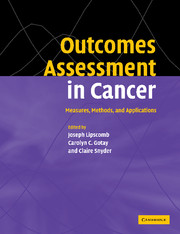Book contents
- Frontmatter
- Contents
- List of contributors
- Acknowledgments
- 1 Introduction to Outcomes Assessment in Cancer
- Health-related quality of life in cancer: general concepts and generic measures
- Assessing health-related quality of life during treatment
- Assessing health-related quality of life across the cancer continuum
- Measuring the experience and needs of cancer patients and caregivers
- Methodological considerations in applications to cancer outcomes research
- Modern psychometric theory in cancer outcomes research
- Assessing the economic impact of cancer
- 24 On the definition and measurement of the economic burden of cancer
- 25 Cost-effectiveness analysis in cancer: toward an iterative framework for integration of evidence from trials and models
- Research and policy implications
- Invited papers
- Index
- References
24 - On the definition and measurement of the economic burden of cancer
Published online by Cambridge University Press: 18 December 2009
- Frontmatter
- Contents
- List of contributors
- Acknowledgments
- 1 Introduction to Outcomes Assessment in Cancer
- Health-related quality of life in cancer: general concepts and generic measures
- Assessing health-related quality of life during treatment
- Assessing health-related quality of life across the cancer continuum
- Measuring the experience and needs of cancer patients and caregivers
- Methodological considerations in applications to cancer outcomes research
- Modern psychometric theory in cancer outcomes research
- Assessing the economic impact of cancer
- 24 On the definition and measurement of the economic burden of cancer
- 25 Cost-effectiveness analysis in cancer: toward an iterative framework for integration of evidence from trials and models
- Research and policy implications
- Invited papers
- Index
- References
Summary
Introduction
Economic analysis should play an essential role in controlling cancer, including defining priorities for research, treatment, screening, and prevention because society's resources are limited.– Competing demands for resources can give rise to decisions with myriad unforeseeable effects on costs, outcomes, and benefit distribution. Patients, families, physicians, and other providers face difficult trade-offs among alternative cancer prevention, screening, treatment, and palliation regimens with differing costs, probabilities of successful outcomes, side effects during treatment, and levels of uncertainties associated with estimates of these parameters. Even seeking additional information to reduce uncertainty about regimen options is costly, and the information gained will be of little value if it is wrong or irrelevant.
The concept of economic burden of disease is central to considerations of how to achieve an optimal resource allocation to and within health care.– Diseases that place the highest economic burdens on society, for example, should receive greater priority in medical and health services research compared to other diseases. Moreover, cancer treatments and prevention services that provide greater reductions in cancer's overall economic burden should receive greater priority in making coverage decisions, developing clinical practice guidelines, and making clinical decisions. Models that forecast cancer's economic burden are needed to understand the relative ranking among the sources of burden; to identify potential disease management opportunities so that appropriate practice guidelines can be developed, tested, and implemented; and to decompose total burden imposed by all comorbidities into cancer-related and cancer-unrelated.
- Type
- Chapter
- Information
- Outcomes Assessment in CancerMeasures, Methods and Applications, pp. 480 - 502Publisher: Cambridge University PressPrint publication year: 2004
References
- 1
- Cited by



